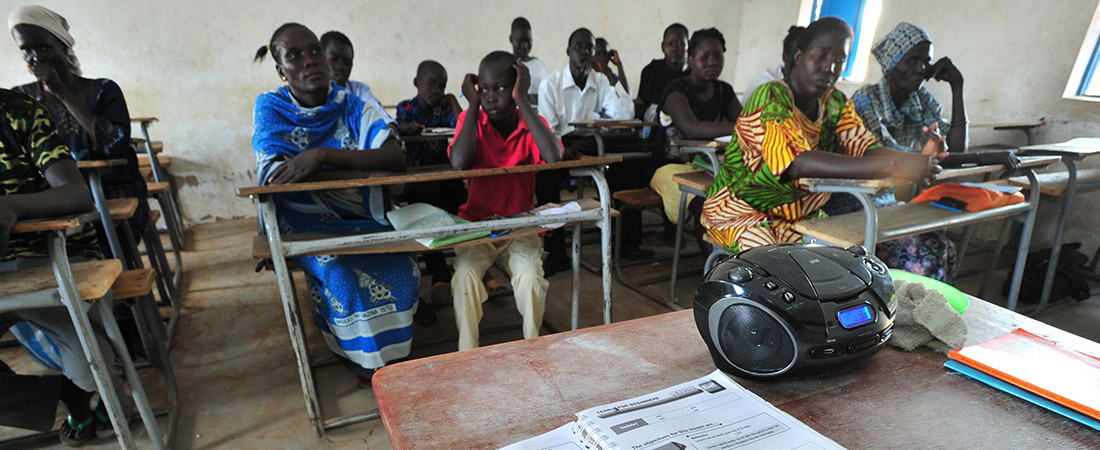Distance Learning: Promising Practices

Mary Burns has more than 20 years of experience in teaching, curriculum development, teacher professional development, research and evaluation, and instructional design. She is the author of the book Distance Education for Teacher Training: Modes, Models, and Methods.
Jim Vetter has more than 20 years of experience in designing and conducting innovative and effective training and technical support activities, both online and in person, domestically and internationally. He is EDC’s project director for HP LIFE e-Learning.
In the past 50 years, as technologies such as radio, television, the Internet, and mobile phones have proliferated, distance learning has grown from mail-based correspondence courses to fully interactive online environments connecting people on all continents. Educators across the world are confronted with some basic questions: How are distance education courses best designed? And what is the role of a distance learning instructor?
Recently, EDC’s Mary Burns and Jim Vetter, two experts in distance learning, shared their ideas.
Q: What is distance education?
 Burns: I think of it as a planned learning experience characterized by some level of physical separation between the instructor and learner. The tools change depending on the context. For example, in the U.S., a lot of distance education is oriented toward getting some sort of certification and occurs in online or blended environments—sites where in-person teaching is combined with other tools.
Burns: I think of it as a planned learning experience characterized by some level of physical separation between the instructor and learner. The tools change depending on the context. For example, in the U.S., a lot of distance education is oriented toward getting some sort of certification and occurs in online or blended environments—sites where in-person teaching is combined with other tools.
Internationally, though, the models are far more diverse. For example, distance learning may involve robust radio and television models that reach hundreds of thousands of teachers. Mobile learning is also on the rise everywhere.
Q: Is online learning the best kind of distance learning?
 Vetter: Online learning is increasingly popular, but its value really depends on the context. Right now, I am working on a project that connects budding entrepreneurs all around the world, and online delivery is perfect for our needs—we can deliver content, and students can connect with peers, whether they are in Mumbai or Oslo. The medium actually helps achieve our project’s goals.
Vetter: Online learning is increasingly popular, but its value really depends on the context. Right now, I am working on a project that connects budding entrepreneurs all around the world, and online delivery is perfect for our needs—we can deliver content, and students can connect with peers, whether they are in Mumbai or Oslo. The medium actually helps achieve our project’s goals.
But it takes time and effort to decide whether an online approach is appropriate. Sometimes the technology infrastructure just isn’t ready, and you have to be more creative about how you deliver learning experiences over distance. For instance, I’ve worked with health professionals in different parts of the world who have sometimes had a difficult time participating in online events because of inconsistent Internet access—or even periodic electrical outages. They are very eager to participate, but the infrastructure simply isn’t there. So when we are talking about the “best” kinds of distance education, it doesn’t make sense to optimize for broadband if the real issue is consistent access to electricity.
On the other hand, the growth of mobile devices is opening up new opportunities to reach people who may not otherwise have consistent access to online learning.
Q: Internationally, what does distance education look like?
Burns: You tend to see two broad types of design. I would call the first “reality-based.” These are programs that use available tools and are mindful of the educational realities of the country. For example, you see a lot of interactive radio instruction [IRI] in Africa because radio is readily available, the Internet is not, and the didactic nature of IRI compliments traditional classroom practices.
You also have “technology-driven” design, which emphasizes use of technology independent of local contexts. I ran a project in an Asian country where this was the case. The ministry of education wanted to push teacher development via online learning, even though only a small percentage of people in the country had broadband access. This project was ultimately a success, though, because we modified instruction and offered significant support to the learners. And I think that raises an issue that is often missing from conversations about distance education—it is so important to support the learner, no matter the tool.
Q: What does distance education mean for the role of the teacher?
Burns: Henry Ford said, “We’ll fix the problems of the cities by leaving the cities behind.” Sometimes I think people look at teacher professional development and think, “We’ll fix the problems of teaching by leaving the teachers behind.” I have talked with many people who think that online learning is computer-aided instruction and therefore circumvents the teacher. I reply that it is not—in an online group-based course, there are humans at every step. Technology is important, but what’s more important are the skills and contributions of the people using the technology.
Q: What makes an effective online learning experience?
Vetter: You need to start with a couple of central questions: “Who are the learners?” and “What are their contexts?” Whatever the distance learning technology, a key strategy is to engage people from the target audience early in the development process to be sure to address their real needs.
A lot of our projects are now using components of different tools to engage the learners. I think that’s a key. We use real-time webinars, discussion boards, and self-paced modules, all of which allow learners to engage in different ways. Designing with multiple tools allows us to reach an increasing number of people in an increasing number of places.
Q: What does the future hold for distance learning?
Burns: I think distance learning will continue to expand since the demand for it is so high. The challenge before us is to keep improving these models, and to keep researching what works and what doesn’t.
I’m perhaps most interested in the growth of online learning within the larger category of distance learning. Online learning is fraught with potential barriers to success. For example, online reading is a much larger cognitive load than reading from a book. And we also know that attrition rates for online learning are higher than in face-to-face models, especially in certain international contexts. But done thoughtfully, online learning can truly be a transformative tool in education. I’ve seen it happen. We just need to stay connected to the central questions that all good teachers ask: “Who are my learners?” and “What do they need?”
Vetter: We know what makes for effective instruction. We have to take that knowledge into the online environment and choose wisely when we design. If we do that, then the learning will be effective.